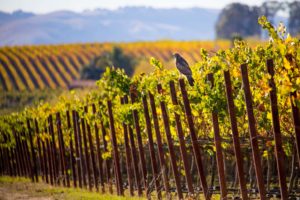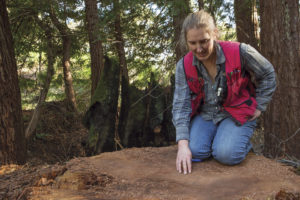South of San Francisco, the Peninsula displays a kind of natural zoning-by-topography. On the east side, along the Bay, is where most people live. To the west is a chain of lofty, forested hills, the Santa Cruz Mountains; farther west is the coast, still largely unspoiled and agricultural, despite some of the highest rural land prices in the United States.
In 1972, South Bay voters established the Midpeninsula Regional Open Space District, supported by property taxes, to buy land on the mountain heights. Besides being a hiker’s paradise, these open space preserves also set some limit to urban expansion. Five years later, the private, nonprofit Peninsula Open Space Trust (POST) was incorporated to work in the same area and beyond.
- In July, 2004, John Arata showed a reporter around his ranch nearthe San Mateo coast. Arata passed away on December 1, 2005, at the ageof 87. Photo by John Green, www.johngreenphotography.net.
Such pairings of a tax-supported public agency and a nonprofit body with similar goals have often proved effective. The private organization can move quickly and work quietly with landowners in a way that a government body cannot; the public agency, for its part, has police powers and a tax base and often takes title to land secured by the private trust. Thus POST’s first acquisition, the prominent peak above Portola Valley called Windy Hill, is now a popular district preserve. Between them, the two organizations now have 75,000 acres in their care.
While the district remains the specialist in mountain parks, POST has evolved a distinct mission: to protect the vulnerable coastal belt, including some of its farms. With this focus has come an increased use of easements. POST now has easements on properties totaling 5,000 acres, approximately one fifth of its holdings. Vice President Walter Moore predicts that more than half of acquisitions from here on out will take the easement form.
Most of the existing easements cover farmland and honor the agriculture that exists. Unlike MALT’s easements, which actually mandate that farming continue, POST’s merely permit it to continue, giving it equal but not superior billing with open space, wildlife habitat, and low-impact recreation.
POST’s first easement, in 1983, was the Michelsen property above Pescadero, part farm, part wild forest. Its most recent, completed in 2004, lies not far away: the 1,300-acre Arata Ranch on Pomponio Creek near San Gregorio, owned by brothers John and Clarence Arata.
The Arata family may have been the founders of the San Mateo pumpkin industry. Before the Depression, the round, colorful squash were grown here strictly as hog feed. One day in 1933, young Clarence Arata was hauling a cartful of pumpkins along the road when a driver pulled over and offered him ten cents a piece. Soon the Aratas were growing 50,000 pumpkins. “We were the only ones for 25 years,” says John. “Pumpkins are a funny thing. They didn’t cost us anything but our work.”
Over the decades the Aratas kept on farming: more pumpkins, dairy for a while, then beef cattle, some supplementary vegetables. Each brother married a girl from a neighboring farm and raised a family on Pomponio Creek. As the years passed, developers knocked on the door. Would they sell at least the flat land near the creek for a few houses? The Aratas weren’t interested. “We didn’t want to ruin the ranch,” says Clarence. “Sell 20 acres, you get a neighbor to contend with.” The quiet of the gentle coastal valley, the subtle colors of grassland and coastal scrub, remained undisturbed. Yet the brothers were getting older and the future was in doubt.
When POST began working on the coast, word of mouth was anything but favorable. It seemed an alien force, yet another of the predators hovering over a declining agricultural heritage. “We heard a lot of stories about POST,” Clarence recalls, “and they weren’t good.”
Then, one day in 2001, John Arata saw a young woman standing on a roadside near the ranch, looking at a map. She was trying to find the best way into a property that POST had just bought in the area, Seaside School Ridge. John stopped the car to offer help. One conversation led to another, and soon the brothers found themselves in negotiations with POST about their own property. When things got serious, they made sure to talk to their neighbors, sharing every detail.
In the end they sold, for $4.75 million, a conservation easement on almost two square miles. As part of the deal, the brothers were able to add to the ranch some useful acreage they had only been able to farm under lease before: Seaside School Ridge. This piece is under easement too.
This particular setup—outright purchase, followed by a resale under easement—is a tool POST has used several times, notably at the North and South Cowell ranches south of Half Moon Bay. It has the advantage of giving the trust a free hand in writing an easement to its specifications.
Both the Cowell properties and the Arata Ranch take their place in larger assemblages of protected land. On Purisima Creek, a green corridor has been built linking mountaintop open spaces to the sea. The same is hoped for at Pomponio Creek, though a couple of pieces are still missing. These corridors protect watersheds, provide routes for wildlife movement, and will eventually serve hikers as well. Easement contracts in both places contain an unusual paragraph: permission for an eventual hiking trail, sited out of the way of farm operations.
Traditional attitudes die hard, but POST’s stock on the coast appears to be rising. Certainly the reports from owners like the Aratas are good. “The only mistake we made,” John Arata says, “was not doing this ten years ago.”

.jpg)




